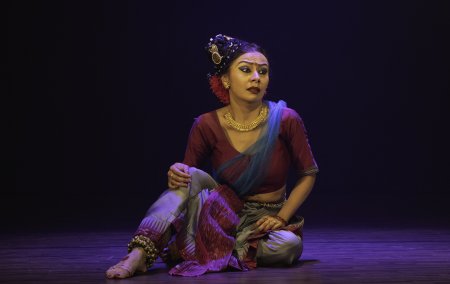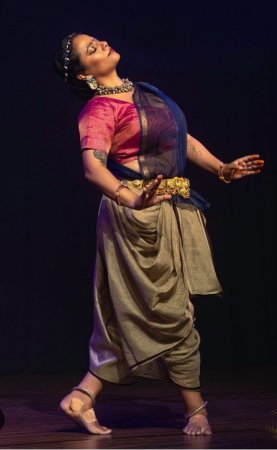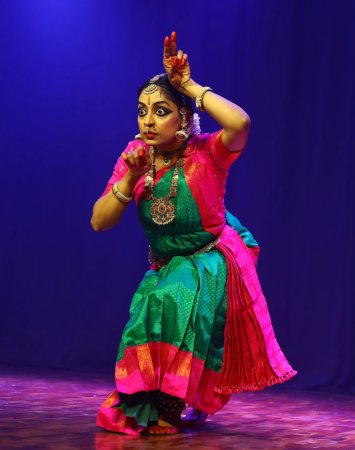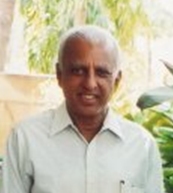
|   |

|   |
A kaleidoscope of rhythm and expression - Satish Suri e-mail: satishism@yahoo.co.in Photos: Rajkumar Doss February 26, 2025 DELIGHTFUL DANCE PERFORMANCES CAPTIVATE AUDIENCE Shilpanatanam presented at Medai, Bangalore, on the 23rd of January by Aalap. is a unique dance style created by Maya Kulkarni that revolutionizes traditional dance performance. It is a creative choreographic vision that transforms visual art into movement, departing from classical dance techniques. 'Shilpa' encompasses sculptures, paintings and architecture, while 'Natanam' refers to movement, expression, and rhythm. Unlike traditional dance forms, Shilpanatanam focuses on broader literary and poetic themes rather than devotional narratives The style brings static images to life, creating dancing metaphors about human conditions that connect past and present.  Kaustavi Sarkar Kaustavi Sarkar, an Odissi dancer, took to the stage to present 'The Impossible Romance' created by Maya Kulkarni. The performance draws from Kalidasa's Meghaduta, a unique love story between a cloud and lightning, diverging from the original narrative while maintaining thematic ties to longing and separation. Kulkarni's choreography reinterprets the narrative focusing on the emotional connection between the cloud and lightning, with the peacock playing a pivotal role as the manipulative yet enchanting intermediary. The peacock lures the cloud toward the lightning, fully aware of the cloud's inevitable demise in the lightning's embrace. This tragic yet poetic love story was brought to life through the expressive language of Odissi. Kaustavi showcased her exceptional command over the form. Her supple, arcing, and circling torso became the canvas for this dramatic narrative, embodying the fluidity and dynamism of the cloud, the peacock, and the lightning. Her movements were both precise and expressive, capturing the enchantment, playfulness, and tragedy of the story. The way she spiralled stretches, and tipped backward, mirrored the unpredictable flight patterns of the peacock and the swirling motion of the cloud. The cloud and lightning were portrayed as lovers drawn together by fate, with the peacock as the intermediary. Kaustavi's depiction of the cloud's journey - its longing, its vulnerability, and its ultimate demise - was deeply moving. The lightning, with its fierce and fleeting nature, was portrayed through sharp, dynamic movements that contrast with the cloud's fluidity. The tragic beauty of their union was captured through Kaustavi's expressive abhinaya and the interplay of light and shadow on stage. Bharathi Penneswaran's exposition of Chhanullal Misra's 'Chaiti', describes a charming and playful depiction of a newly married couple whose intimate moment is interrupted by the relentless singing of the Koyal bird (the Indian cuckoo). Koyal's song, often associated with spring and romance, ironically becomes a source of frustration in this context. The lover's complaint to the bird - threatening to tie its beak so it can sing no more - added a touch of humour and relatability to the situation. This lighthearted portrayal of human emotions and nature's interference is a hallmark of Chaiti compositions, which often explore themes of love, longing, and the playful dynamics of relationships. Through her innovative interpretation, Bharathi not only paid homage to the rich traditions of Chaiti and Bharatanatyam but also created a work of art that resonated with the audience on multiple levels.  Bharathi Penneswaran Maya Kulkarni's choreography, which integrates Bharatanatyam with semi-classical music, is a shining example of the fluidity and interconnectedness of Indian classical arts. By blending the structured elegance of Bharatanatyam with the emotive and lyrical qualities of semi-classical music, she creates performances that are both technically brilliant and expressive, offering new possibilities for creativity and innovation. 'Rati Vilapam' was a deeply evocative and poignant portrayal of Rati's grief after Madana (Kamadeva) is reduced to ashes by Shiva's wrath. The composition beautifully captured the emotional turbulence of Rati as she searches for her beloved, questioning the very elements of nature - birds, flowers, and the surroundings - only to be met with silence and emptiness. The imagery of the chakravaka bird, eternally longing for its mate, further deepened the sorrowful mood. Kaustavi Sarkar's brilliant interpretation captured the emotional depth of Rati's sorrow and the rich poetic illusions embedded in the narrative. Her wailing and lamentation were juxtaposed with the cosmic tandava performed by Shiva, symbolizing the duality of creation and destruction. The contrast between Rati's anguished lament and the powerful tandava of Shiva created a striking visual and emotional impact. The depiction of Rati's writhing and wailing, alongside Shiva's fiery dance, underscored the delicate balance of love and destruction, devotion and despair. Maya Kulkarni was inspired to create the dance piece 'Yakshini' by the unique and magical architecture of the '64 Yogini' temples in Orissa. She encountered one of these temples near Bhubaneswar, which features a design built in triangles and circles, symbolizing infinity and cyclical nature of existence, Tantric symbolism, where these shapes represent the interplay of masculine and feminine energies, as well as the balance of creation and destruction. This architectural inspiration was reflected in the choreography, where she captured the triangular shapes through distinct Jaati counts (Khanda, Tisra, and Mishra) and represented the temple's pillars through Chatusra Jaati. The absence of a roof in the temple design creates a sense of unity with the sky and nature, further enhancing the thematic depth of the piece. Additionally, 'Yakshini' explores Tantric symbolism through movement, drawing geometric shapes that connect to the spiritual essence of the Yakshinis represented in the performance. Overall, Kulkarni's work reflects a deep engagement with both architectural and spiritual elements, creating a narrative that intertwines dance with cultural heritage. Bharathi Penneswaran's incorporation of three Yakshinis - Narsinghi, Chinnamasta, and Saraswati - added a fascinating layer of complexity and symbolism to the narrative. Narsinghi is a fierce form of the goddess, often associated with protection and the destruction of evil. She is depicted with a lion's face, symbolizing courage and strength. Chinnamasta is one of the Mahavidyas (great wisdom goddesses) in Tantric tradition. She is depicted as self-decapitated, holding her severed head, with blood flowing from her neck to feed her attendants. Saraswati is the goddess of knowledge, music, arts, and wisdom. She is typically depicted as serene and graceful, holding a veena and a book. The depiction of Saraswati sporting a moustache in the Asputa stage (half-manifested state) is particularly intriguing. This could symbolize the androgynous nature of divine energy, where masculine and feminine qualities coexist. It might also represent the unconventional and transformative aspects of wisdom, challenging traditional notions of gender and form. This piece showcased mastery in transforming mythological figures into living, breathing art. The precision of her mudras and abhinaya brought out the Yakshini's playful yet potent essence, hallmarking the choreographer Maya Kulkarni's ability to animate the inanimate. 'Yakshini' is not just a dance; it's a meditation on femininity, power, and the liminal space between myth and reality. SRI VINODHA Photos: Murali mass photography The solo Bharatanatyam presentation titled 'SriVinodha' by Gowri Sagar, performed on 26th January at the Shukra Auditorium, was a refreshing and innovative exploration of the Dasavatharas (ten incarnations) of Lord Vishnu, uniquely portrayed through the Hasya Rasa (the sentiment of humour). This creative approach, combined with Gowri Sagar's exemplary execution, made the performance a memorable and delightful experience.  Gowri Sagar The performance began with an Alarippu, a traditional Bharatanatyam piece that sets the rhythm and tone for the recital. However, Gowri Sagar infused it with humorous interludes, making it engaging. The Alarippu featured Parvati playfully cautioning Ganesha to watch his ever-expanding belly as he indulged in his favourite modakas (sweet dumplings). This lighthearted interaction between mother and son immediately established the mood of the evening. The entry of Subrahmanya, who was praised for his dancing skills, added a sibling rivalry element, much to Ganesha's discomfiture. Parvati's pacification of Ganesha by addressing him as "Natya Ganapati" (the lord of dance) was a clever and humorous touch, blending devotion with playfulness. The performance framed the Dasavatharas from the perspective of Lakshmi, offering a fresh and entertaining take on these stories by exploring her playful musings on Vishnu's avatars. Two friends at a temple dedicated to Vishnu and Lakshmi, debate whether they are an "ideal couple". Vishnu on the Serpent (Ananta Shesha): The friends question how Lakshmi enjoys sitting on a snake, pondering the serpent's skin and hissing. Matsya Avatar (The Fish): The friends joke about how Lakshmi dealt with the smell of a fish as her husband. Kurma Avatar (The Tortoise): The friends question how Lakshmi could keep pace with the tortoise's slow movements. Varaha Avatar (The Boar): The friends laugh about how Lakshmi could sit on a boar's lap. Narasimha Avatar (The Man-Lion): The friends imagine Lakshmi staring at a ferocious lion's face daily. Vamana Avatar (The Dwarf): The friends joke about Lakshmi confronting a little Brahmin who grew in size and vanished. Parashurama Avatar (The Warrior Sage): The friends remark that no one would approach Lakshmi with such a temperamental angry husband. Rama Avatar (The Prince of Ayodhya): The friends point out that Lakshmi had to endure 14 years of exile with little food or sleep. Krishna Avatar (The Divine Cowherd): The friends note that with 16,000 wives, Lakshmi wouldn't worry about competition. Buddha Avatar (The Enlightened One): The friends joke that even an owl lost its way trying to understand his wisdom. Kalki Avatar (The Future Incarnation): The friends imagine Lakshmi waiting in anticipation for her husband to appear.  Gowri Sagar Gowri Sagar's abhinaya was a highlight, as she transitioned between characters and emotions to bring out the humour in each avatar's story. Her nritta was precise and energetic, with crisp footwork and graceful movements that complemented the playful tone. The use of Hasya Rasa was consistent throughout, and her facial expressions and body language were attuned to the comic narrative. By blending tradition with creativity, Gowri Sagar created a memorable and joyous experience, infusing humour into divine narratives while maintaining their spiritual essence. This creative approach offered a fresh perspective on Vishnu's avatars, making the performance spiritually uplifting and delightfully amusing. The musical accompaniment was a testament to the power of collaboration and creativity in Bharatanatyam. The exemplary music composition of Mahesha Swamy, and the contributions of Vasudha Balakrishna, Nitish Amannaya, Bhavani Shankar, Chaitra Jagadish and Pruthvi Parthasarathy added richness to the performance, making it a truly exceptional artistic experience. Their ability to complement the theme with playful rhythms and melodic phrases, while maintaining the sanctity of the traditional art form showcased their exceptional talent and dedication. Together, they created a musical tapestry that perfectly complemented Gowri Sagar's innovative choreography. The performance showcased Gowri's understanding of Bharatanatyam as a medium for storytelling. She created a memorable and joyous experience for the audience, proving that humour can be a powerful tool for connecting with the divine.  Bangalore based Satish Suri is an avid dance rasika besides being a life member of the Music and Arts Society. |